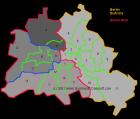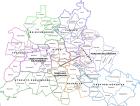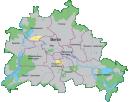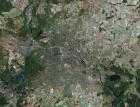Trip to Berlin
Reise nach Berlin
by N. Richard Wagner
Copyright © 2006 by N. Richard Wagner, all rights reserved.
... [a] dark inevitability ... seemed to attend the progress of Berlin throughout the 20th century, dragging all the rest of us along. There is something almost occult in the nature of this city. Its streets are haunted, and not by personal ghosts, but by the ghosts of ideas, policies and ambitions ...Only Berlin bears the several stigmata of Prussian militarism, Weimar decadence, Nazi evil, Stalinist oppression and tawdry capitalist excess.
This is largely because, throughout the 20th century, Berlin has been a capital city. Here, the Kaiser's generals planned their offensives, Eichmann calculated the logistics of the Final Solution, Honecker's border-guards murdered citizens looking for a better life, and for a few decades the gaudy materialism of the Kurfurstendamm was the world's most vulgar proclamation of democracy.
Jan Morris, Review of Berlin by David Large. (Local Copy of Review)
Introduction
I vacationed in Berlin from the 12th to the 25th of October in 2006. This was my fifth trip to Berlin, the others being in 1962, 1963, 2000, and 2003. In 1962 I was in Hamburg for a year on a student exchange program with a Fulbright travel grant. The Fulbright people invited everyone to get together in Berlin in the Fall. I enjoyed the city so much that I went back on my own for 10 days the next Spring (in 1963). The stark 37-year gap between visits in 1963 and 2000 was broken by a visit to München (Munich) and Linz, Austria in 1985. I went to a computer science conference in Linz, and before and after the conference I was able to stay with a friend who lived in Munich. In 1999, my son John, who was 15 at the time, received a scholarship from the "Congress-Bundestag" exchange program to study for a year at a high school in Germany. They paid for everything, even the airfare. He was assigned to live with a very nice family near Potsdam, which is only a half-hour train ride from Berlin. For privacy reasons I'll call them the Meier family here. In 2000 I visited John and stayed with the family for a week, and then stayed a few days in the center of Berlin. In 2003 my wife and I visited John again, giving her a whirlwind tour of Berlin for 3 days. She returned to the states while I remained for 10 more days. This trip in 2006 was also to visit my son.
I know these visits don't make me any kind of expert on the city of Berlin. It's particularly dangerous for a foreigner to write of his "impressions" -- besides missing very much altogether, such a visitor can commit two kinds of errors: first, seeing something and completely misunderstanding it, and second, seeing something that is understood, but falsely assuming it is common or representative when it is rare. I've tried to avoid these mistakes by talking with a number of Germans.
To further compound these difficulties, I don't speak German as well as I would like, understanding and reading it much better than speaking.
On this fifth visit I stayed away from many of the standard tourist sights that I had seen before. My son John lives in Kreuzberg, an interesting section south of the city center, with a variety of people living there -- some sections trendy and some poor.
During the visit I took about 400 low-tech pictures, and I'll stick thumbnails of these in with the exposition. I'll also include other photographs from the Internet.
Berlin is divided into "Districts" (Bezirke). Below are maps showing these Districts. Notice the Kreuzberg district just south of the Mitte (center) district, which is indeed the center of Berlin. The map on the far left shows the status of Berlin just after the war, when there were 4 sectors, as shown. In [fill in date] the three sectors to the west were combined into West Berlin, a part of West Germany, while the Soviet Sector, also called East Berlin, was a part of East Germany. (Officially the eastern part was called the Deutsche Demokratische Republik (DDR, or German Democratic Republic (GDR).) This map also shows the course of the Berlin Wall (die Mauer) erected in 1961, and opened and then torn down starting on November 9, 1989.
In 2001 various pairs of districts were combined into single districts in order to save money and be a more sensible organization. The second map from the left and the second map from the right show these larger districts. Notice that Kreuzberg had become the larger Friedrickshain-Kreuzberg, but people still talk of living in "Kreuzberg.
The two pictures at the right below show the extensive forests and lakes in Berlin. The area beyond these pictures also has forests and lakes. Add to these attractions the absence of overhead power and telphone lines, so often strung on ugly telephone poles in the US, and the missing annoying billboards along roadways, and one gets a beautiful city. (Berlin has high-voltage power lines, but the others are buried underground. We bury these lines sometimes in the US, but burying is more expensive.)
 |
 |
 |
 |
|||
| Districts 1985 | Districts Current | Forests and Lakes | Aerial View | |||
|---|---|---|---|---|---|---|
| Maps of Berlin | ||||||
Memories
I find Berlin a city full of dark memories. The Germans have tried to forget some of these memories, or even succeeded in forgetting. In other cases the record of events is explicitly recorded and publicly displayed to keep the memory intact.
Berlin is not unique in this regard: in the United States we also have our forgotten memories, for example with the treatment of Native Americans and Blacks. As a specific case in America, Brown University recently made public the extensive involvement in the slave trade by those associated with the school. This was a memory that they have bravely reawakened after it almost disappeared, as most Americans think the north wasn't involved with slavery. See Brown University: Slavery and Justice.
In Berlin all but the youth remember a city divided by the wall (die Mauer) until 1989, but there is now hardly any trace of the physical wall. Still, the memory of a divided city remains strong, and most Berliners remember where the wall was, while a tourist would have no clue. Moreover, social and cultural differences between the former East and the former West linger. For example, there are at present (2006) more than 200 thousand Muslims living in Berlin, but there is not a single mosque in the former East Berlin. Current plans for a new mosque in Pankow are meeting with strong protests from people who fear an influx of Muslims into their neighborhood. As another example, supposedly fewer than half of all former West Germans (Wessis) have visited any part of the former East since the wall came down.
In Berlin many other memories from the past come bubbling up: the difficult times after reunification; a divided Germany before then, with separate stories that impinge on one another; and the twelve years of the Nazi time. Some still remember the time between the wars, and at least there are stories about the first world war. Just as we Americans have done, Germans have created myths to explain or justify past events. One also sees ironic juxtapositions in the Berlin of today: for example, the busy traffic and fortified American embassy (under construction) right next to the new Holocaust Memorial.
I have asked myself when the Germans were really happy in the Twentieth Century, since it was such a difficult century for them to get through. I believe there were two striking times. On Saturday, March 7, 1935, at 1 p.m., German troops approached the Hohenzollern Bridge in Cologne (Köln) and crossed into the demilitarized zone of the Rhineland. This was a decisive and daring step of asserting Germany's sovereignty and power.
Thousands packed the banks of the Rhine and thronged the streets near the bridge. The soldiers received a delirious reception as they crossed. Women strewed the way with flowers. Catholic priests blessed them. Cardinal Schulte offered praise to Hitler for "sending back our army."It was almost impossible not to be caught up in the infectious mood of joy. It extended far beyond firm Nazi supporters.
Ian Kershaw, Hitler, 1889-1936: Hubris,, 1998, pages 588-590.
As we now know, this was a false joy, the start of a descent "into the abyss," to use Kershaw's terminology.
The second time of happiness came on the evening of November 9, 1989, when the East Germans opened the wall, partly reuniting a divided city. Exactly how the wall opened up is part "urban legend", with Germans telling different stories. The version reported in the Spiegel magazine, 8 November 1999, pages 85-100 (for the tenth anniversary of the Mauerfall) certainly sounds authoritative. It turns out that in part the opening of the wall depended on the use of a single word. I give this portion of the story below, in German and with a translation :
| Original Text | Translation | |
|---|---|---|
|
Dann kommt er [Schabowski] zum Punkt: Allerdings "ist heute, soviel ich weiß, eine Entscheidung getroffen worden". Der Ministerrat habe beschlossen, "heute, äh, eine Regelung zu treffen, die es jedem Bürger der DDR möglich macht, äh, über Grenzübergangspunkte der DDR auszureisen".
"Ab wann tritt das in Kraft?"
Dann aber unterläuft Schabowski ein für
Schabowski meint natürlich: morgan früh,
| Then he [Schabowski] gets to the point: Certainly "today, as far as I know, a decision has been made". The ministry secretary has decided, "today, um, to make a regulation, that every citizen of the GDR is allowed, um, to leave the GDR at the border crossings".
"Starting when will that go into effect?"
But then Schabowski makes a mistake which is
Naturally Schabowski means early tomorrow,
|
Thousands of East Berliners headed for crossings into West Berlin. The border guards became increasingly nervous, as more and more people pressed against a crossing point. Some guards feared for their lives as they decided to open up the crossing.
A more recent and more complete story of how the wall came down is in Die Nacht der Wildschweine, Der Spiegel, 2 November 2010.